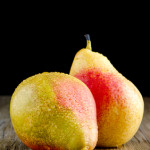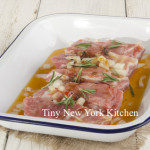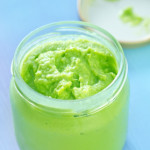Ice Tea or Iced Tea? It depends on where you live. In the South, it’s called ice tea and everywhere else it’s called iced tea.
Iced tea did not take its current form until the popularity of black tea took off, thanks to the work of the Indian Tea Commission at the St. Louis World’s Fair in 1904. As the legend goes, Richard Blechynden, the head of the commission, watched the fairgoers pass by his elaborate teahouse as the sweltering temperatures made hot beverages unpalatable. Driven to increase the market for Indian black tea in the States, he hit upon the idea of not only serving it iced, but also perhaps more importantly, giving it away for free. His booth was soon the most popular at the fair as the patrons found his golden beverage to be the perfect refreshment.
Spurred on by his success in St. Louis, Blechynden toured the country, giving away more and more iced tea, quickly spreading its popularity nationwide. Brewing the perfect iced tea at home, complete with sweet and often fruity syrups, soon became the hallmark of a great hostess. Iced tea was mixed with all sorts of flavors in delicious punches; lemon, mint, strawberries, cherries, and oranges, whether fresh, preserved, or in syrup form or, for the more mature palette, brandy and bourbon to give it a little extra kick. And though few still have time for such an elaborate and time-consuming production (early recipes recommend beginning to brew tea at breakfast for service at dinner), iced tea remains an American favorite, available in bottles, cans, and even from a soda fountain.
To make iced tea use double the amount of tea or teabags that you would use for hot tea when you’re planning to chill the drink. And allow the tea to come to room temperature before you put it into the refrigerator. Fill an ice cube tray with tepid tea and freeze for ice that won’t dilute your drink. You could also float some minced mint or fruit in the cubes for a special treat.
“Work With What You Got!”
© Victoria Hart Glavin Tiny New York Kitchen © 2017 All Rights Reserved
Happy Independence Day!
Just one of the many things I love about living on the East Coast…the beauty of the light in between thunderstorms.
Probably the first vegetable to be cultivated by man, ancient peas and beans have been found in settlements from the late Stone Age onwards (nearly 8,000 years ago). They are a highly nutritious vegetable, containing essential carbohydrates and proteins, as well as useful supplies of vitamins and minerals. They were particularly valuable to ancient man as they could be dried and stored, which meant that food was available throughout the year.
Garden Peas: These are one of the delights of summer, although they are one of those vegetables that are best when absolutely fresh. Pick your own (if you don’t grow them yourself) is the best way to enjoy peas at their best. There are many varieties of peas, some of which can be eaten whole, including the pod. Peas are one of the few vegetables that taste almost as good when frozen. Because freezing takes place soon after picking, frozen peas often have a higher nutritional content than fresh, and are available all year round.
Mangetouts: These are eaten whole and are valued for their pods, rather than the peas, which never mature. Mangetouts have a delicate, sweet flavor. To prepare, young, freshly picked mangetouts simply need to be topped, tailed, and washed. They should be cooked only briefly to retain their delicate, mild flavor and crisp bite. They can be blanched or stir-fried and are also good served raw in salads.
Petits Pois: These are not, as you might expect, immature peas, but are a dwarf variety. They are wonderfully tender and have a sweet, delicate flavor. Gardeners grow their own, but petits pois are not widely available fresh in the shops as they are mainly grown commercially for canning or for freezing.
Snow Peas/Sugar Peas/Sugar Snap Peas: These have the distinct fresh flavor of raw peas and are plumper and have more “snap” than mangetouts. They are delicious added raw to salads. They are also good steamed or boiled, but should only be cooked for about 1 minute or they will lose their wonderful flavor and texture.
Buying And Storing: Only buy really fresh peas. If they are old they are bound to be disappointing. In top condition, the pods are bright green and lively looking. The more withered the pod, the longer ago they were picked. Use fresh peas as soon a possible.
www.tinynewyorkkitchen.com
“Work With What You Got!”
© Victoria Hart Glavin Tiny New York Kitchen © 2017 All Rights Reserved
There are almost as many varieties of pears as there are apples, but only a dozen or so are readily available in stores. Pears are related to apples, but are much more fragile and are more often eaten raw than cooked. They have fine white granular flesh and a core containing the pips (seeds). Most pears are wider at the bottom than the top, but some are apple-shaped, while calabash pears have an elongated neck, like a gourd. Pears tend to be less vividly colored than apples, usually varying from bronze to gold, green or yellow, although there are also some red-bushed varieties such as Red Williams and Forelle.
Anjou: These large pears have greenish yellow skin with small brown spots. The flesh is juicy and sweet. Suitable for eating and cooking.
Beurre Superfin: Large, with a tough golden green, russet skin, this is the perfect eating pear. Its flesh is sweet and juicy and it is less grainy than other pears.
Conference: First cultivated in the English country of Berkshire in 1770, these long, conical pears have remained a favorite because they keep so well. The yellowish-green skin with extensive russet turns more yellow when the pears are mature. The granular flesh is tender, sweet and juicy. Conference pears are excellent for eating and cooking.
Comice: This large, roundish pear is one of the finest of all pears, with creamy white, melting, very juicy flesh and a sweet, aromatic flavor. The thick, yellowish-green skin is covered with speckles and patches of russet. Comice are best eaten raw and they are delicious served with Camembert or Brie cheese.
Forelle: This beautiful golden pear has a dark red flush on one side. The grainy flesh is crisp, with a fresh flavor. Eaten raw, it goes particularly well with cheese, but is at its best when cooked.
Laxton’s Foremost: Yellow-skinned and lightly russet, this is one of the largest pears. Its creamy colored flesh is very juicy and granular. It does not keep well and, as it turns brown from the inside out, there may be no external signs that the fruit is past its best.
Packham’s Triumph: The first successful Australian pear was produced by Charles Packham in 1896 and remains a favorite. Slow-ripening, it is a largish dessert pear, with a smooth green, lightly russet skin that changes to yellow as it ripens. The soft white flesh is succulent and sweet, with a touch of acidity.
Red Williams: These pears have shiny, speckled skins, at first green with a red blush, turning to yellow flushed with red. The flesh is sweet and juicy.
Bartlett/Williams Bon Chrétien: These irregularly shaped pears are generally swollen on one side of the stalk. The speckled skin is golden yellow with russet patches and sometimes a red tinge. The delicious tender flesh is creamy-white and very juicy, and the flavor is sweet and slightly musky. Bartletts are suitable for cooking and eating, but unfortunately these superb pears do not keep well.
Winter Nelis: This roundish medium-size pear has thick, but tender greenish-yellow skin with cinnamon-brown russet and sometimes a pink flush. The creamy-white flesh is soft and very juicy, and the flavor is sweet. These pears can be cooked or eaten raw.
Perry Pears: With the demise of the most famous of the sparkling alcoholic pear drinks, perry pears have largely fallen into disfavor. A few small producers still press perry pears into juice, wine or “champagne” perry, but although there are still about 300 known varieties, you will never find these in stores. Perry pears are smaller than their dessert counterparts. Although they look delicious, they contain large quantities of tannin and taste bitter and astringent, whether raw or cooked.
Asian/Nashi Pears: There are many varieties of Asian pears, but their characteristics are very similar. They are round rather than a pear shape, the fruits have a golden brown russet skin and they have very crisp, white juicy flesh. The crunchy texture resembles that of an apple, but is more granular. It would be a shame to spoil the crisp texture by cooking. Asian pears are best eaten straight from the refrigerator, to be enjoyed as a “drink of the stalk”. They also make an excellent addition to fruit salads or savory winter salads.
Tientsin: These Asian pears from China and Korea are very similar to Asian Nashi pears in taste and texture. They are available when Asian pears are out of season. They look rather like elongated apples, tapering gently at both ends. The skin is pale yellow, slightly speckled with patches of light brown. The pure white flesh is exceptionally juicy and crunchy.
Hosui: These pears have much the same crunch and juiciness of the Tientsin pears, but look more like apples, with green-brown mottled flesh that tastes like a cross between an apple and an unripe pear.
Buying and Storing: Always buy pears when in perfect condition, as they deteriorate quickly. Once past their best, they become wooly and squashy and unpleasant. Test for ripeness by pressing gently; the fruit should give a little, but still be quite firm. Once ripe, eat within a couple of days. They can be kept at the bottom of the refrigerator for a few days. Store unripened pears at room temperature, where they will ripen in two or three days.
Preparing and Cooking: The majority of pears are eaten raw, by themselves or with a robust cheese such a Stilton or Roquefort. Pears Savarin, halved fruit filled with Roquefort mashed with a little butter are served chilled with double (heavy) cream and paprika, is a popular appetizer. Pears also make a good addition to winter salads. Whether or not to peel pears before eating raw is a matter of preference, but they should always be peeled before cooking. Pears discolor quickly once they are peeled, so rub the cut surface with lemon juice or place in a bowl of water acidulated with lemon juice. If the recipe involves cooking the pears in wine or sugar syrup, the fruit can be put directly into these to prevent them turning brown.
Most varieties of pears are suitable for cooking, but some are specifically designated cooking pears, although commercial production of these is now decreasing. If appearance is important, choose even-size, classic pear-shaped pears such as Comice, Conference or Bartlett. For whole poached pears, simply peel with a stainless steel vegetable peeler, leaving the stalk on. Use an apple corer to core the pears if you want to stuff them with nuts or dried fruit. Poach in port or red wine spiced with cinnamon, cloves and thinly pared lemon rind, or in a vanilla-flavored syrup. For sautéed or grilled (broiled) pears, peel and quarter the fruit and scoop out the cores with a melon baller. Sauté over a low heat in unsalted butter or grill (broil), turning once, watching very closely to avoid the fruit scorching.
Pears can be used in a wide variety of desserts, including tarts, mousses, soufflés, sorbets, and ice creams. They are also delicious grated into tea breads. Pears go particularly well with nuts, especially walnuts and almonds, in both sweet tarts and savory winter salads.
Like apples, pears complement game, particularly duck and hare, while venison garnished with pears is a German specialty. For additional luxury, the pears may be cooked in pear brandy, also known as Williamine, or pear liqueur. Pears can also be roasted with small game birds and then rubbed through a sieve and served as a sauce. A slightly more unusual, but delicious combination is lamb and pears, slow cooked in a casserole. Pears also feature in soups, most famously with watercress and also with garden peas.
Fruit vinegars have come back into fashion and steeping pears in vinegar to flavor it has a long history in country and farmhouse cooking. The vinegar is a rich golden color. It can be used in salad dressings, as part of a basting mixture when roasting rich meats, especially duck, or for deglazing the cooking juices after pan-frying liver or duck to make a sauce. Pear chutney is also a traditional rural favorite, not least because you can use hard, windfall pears that would otherwise have to be thrown away. Pears can also be steeped in brandy for several weeks to make a liqueur for drinking after dinner. A more modern variation of this is to steep the fruit in vodka.
“Work With What You Got!”
© Victoria Hart Glavin Tiny New York Kitchen © 2017 All Rights Reserved
It’s so easy, but takes a tad bit of planning. Just pop meat in a heavy-duty resealable bag with your favorite marinade in the morning, refrigerate, and later in the day all you have to do is throw flavorful meat on the grill. You’ll be so impressed with yourself that you’ll feel like giving yourself a gold star! Make sure to place the bag in a bowl in the fridge to be safe. Sometimes, when I’m particularly crunched for time, I use classic Italian dressing as my go-to marinade.
Five Things To Marinate In Classic Italian Dressing
Flank Steak
Chicken Breasts
Butterflied Leg Of Lamb
Boneless Beef Short Ribs
Most Anything On A Skewer
“Work With What You Got!”
© Victoria Hart Glavin Tiny New York Kitchen © 2017 All Rights Reserved
Grilled pineapple is so very versatile because you can use it for savory or sweet, hot or cold dishes. Grill over indirect heat and the sugars in the pineapple concentrate bringing out a sweet and meaty fruit that is ideal for endless summer recipes.
6 Ways To Use Grilled Pineapple
Slice and serve with grilled pork or fish.
Cut into chunks and toss with salt and lime juice for a smoky fruit salad.
Muddle and use as the base for a sweet-savory cocktail.
Dice and mix with chopped cilantro and chiles for salsa.
Purée and spoon over vanilla ice cream or good Greek yogurt.
Top with ice cream or sorbet.
“Work With What You Got!”
© Victoria Hart Glavin Tiny New York Kitchen © 2017 All Rights Reserved
Wasabi is a rare and expensive root, primarily grown in Japan. It is difficult to grow because it requires a rocky stream or riverbed. The best sushi restaurants prepare it fresh. Once wasabi is grated it loses its complex flavor in just fifteen minutes. More often than not, it is replaced by either prepared wasabi paste, a mix of flavored powder and water, or dyed horseradish, a close relative.
“Work With What You Got!”
© Victoria Hart Glavin Tiny New York Kitchen © 2017 All Rights Reserved
It’s spring here on Martha’s Vineyard and the lure of island life is enticing me to sit, drink a a cup of tea, and have a little nibble of a picnic.















